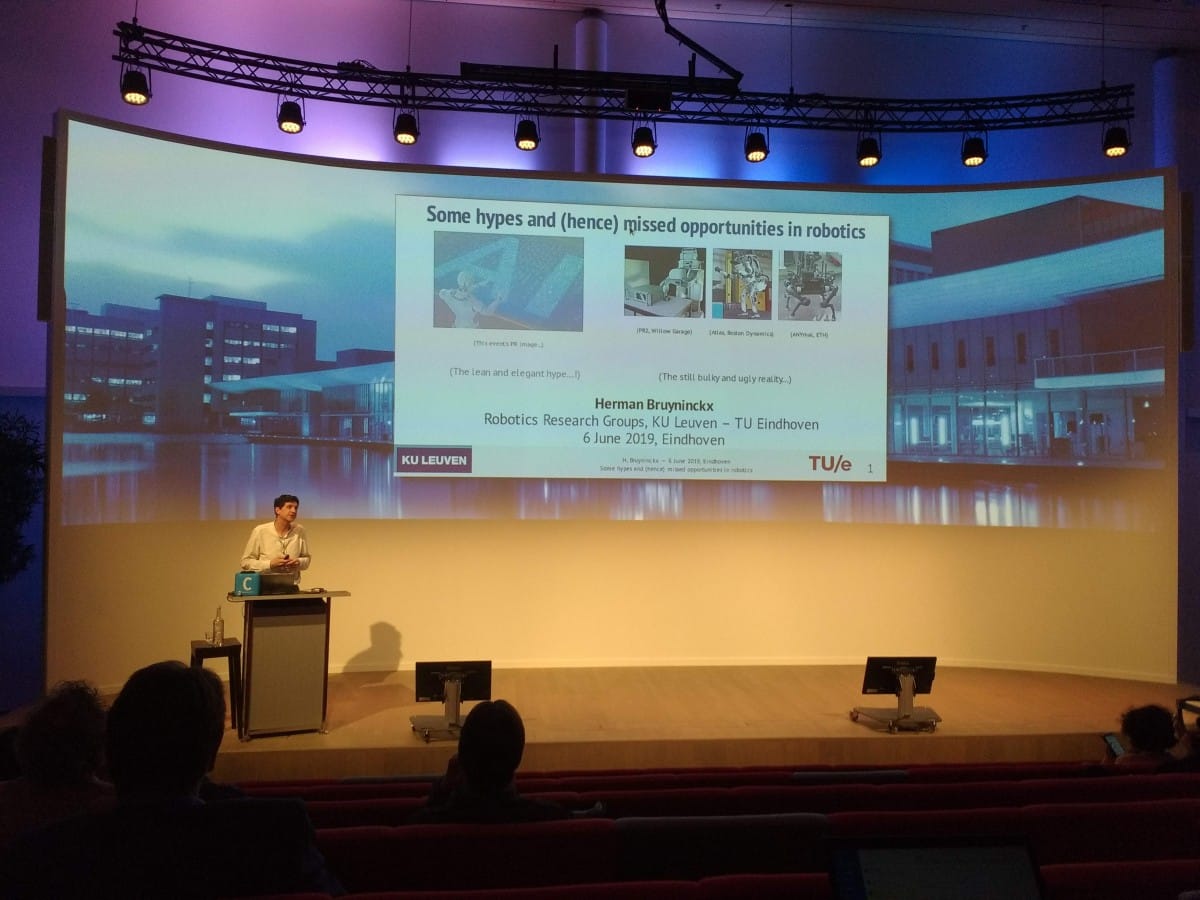
Prof. Herman Bruyninckx (KU Leuven) presented a critical view on the robotics industry during the seminar in High Tech Campus Eindhoven. Bruyninckx delivered a talk on the hypes and missed opportunities in robotics pointing out the key issues that robotics should tackle nowadays.
Herman Bruyninckx has a background in mathematics, physics, computer science and “Philips” mechatronics. He has worked as a roboticist since 1988. Now he is a professor of KU Leuven and TU/e. Herman Bruyninckx’ research focus is robotics as the science of the integration of the systems-of-systems.
Does more computing power lead to better robot systems?
Herman Bruyninckx believes that what robots lack nowadays is the awareness of the users’ intentions and the ability to use abstraction. “50 years after the “first robot” Shakey you can still you go to a robotics conference and understand everything there – because the context and the mathematics are exactly the same. Intention and abstraction of the robots are still very underdeveloped. We need higher-order logic to make the robot aware of why it should be doing something but there is no formal language to represent that. We cannot even formalize what we humans know about the intentional context,” says Bruyninckx.
Context is everything
“There are different levels of perception, and we change them all the time automatically,” says Bruyninckx. “If I’m walking along the stage and I’m not paying much attention to the edge, I’m not going to drop off here. Even if I do, it’s not so high. But I would move completely different if I hold a baby in my hands. Baby will have an impact on all of my control settings, on all of my perception settings. So the context of the task changes everything. But the robots haven’t even started using that kind of context-dependency.”
Abstraction
“We don’t memorize how many people we saw in the cafeteria – lots of background noise is erased. All that we use in our education is abstraction. Humans use abstractions so much and so long that they don’t understand anymore how difficult it is. And we want the robots to learn how to use abstraction by showing them sensors’ data. Then why don’t we teach our kids maths by showing them 1000 million equations?”
Deep learning, according to Bruyninckx is just a new buzz word. “It has nothing to do with deep and nothing to do with learning,” argues Bruyninckx. “It’s all about data reduction. Robots need hard human thinking, not ICT support.”
Robots and environment
“Now robots are kept away from touching the environment, but it shouldn’t be so,” says Bruyninckx. “If I need to take something from the table without looking, I will take it by touching. Touch is really important for most of the tasks.” Bruyninckx and his research group conducted tests on active sensing with people: a person was blindfolded, unable to hear and was wearing very thick clothes. It’s the best possible approximation of a human to a robot.
Open source
ROS (Robot Operating System) is the open source that has conquered the world. In prof. Bruyninckx’s view, ROS has its bad practices. “If it is open-source it doesn’t mean that it automatically gets improved. The first thing that people do when they need to use this open source is forking and fragmenting it.” According to Bruyninckx, ROS has become a monopoly and misses meritocratic credibility to prevent fragmentation.
Where is the state-of-the-art in robotics?
According to prof. Bruyninckx, making an academic career in robotics has become too easy. “Too many old simplistic ideas are coming back again and again. It’s popular to have simplistic solutions but they won’t work,” says the KU Leuven professor.
Another problem of robotics in the academic system is the lack of standardization. “Where are you going to look if you want to know the state-of-the-art in robotics? I don’t know where to find it. There are hundreds of thousands of papers claiming that they are state-of-the-art. We did an extremely bad job in robotics as an academic system. In many cases, Wikipedia can be by far your best source about the state-of-the-art in robotics is.”
Access to knowledge problem
Bruyninckx points out that his work as a university professor is paid 100% by tax money. “When I am hired by a university, that means that your kids only have access to my knowledge in that university because universities don’t work together. I think, people who pay taxes so well should have a lot more value for their money.”
As Bruyninckx says, big IT companies are privatizing decades of public investment because of the lack of open standard regulations. “Robotics is scary. They put things behind the login and all the public knowledge becomes private,” says KU Leuven professor.
Technical conclusions
“Robots need a lot more formalization and standardization to allow the robots to cope with intention, abstraction and context.”
“Progress is value-added, robot-centric applications will profit more from advances in mechatronics and materials than ICT and AI: our robots must touch the environment, including people and plants.”
Bruyninckx believes that materials should be important for the robotics. “Look at yourself, how great these materials are! There is so little friction in our body. Robotics needs new materials. No more computers, networks, sensors. There is more than enough information and computing power.”
“I was in Silicon Valley for a long time and I can say it’s better here, in the Netherlands and in Flanders. We have more potential with robotics then Silicon Valley because we have not only software but the machines.”

